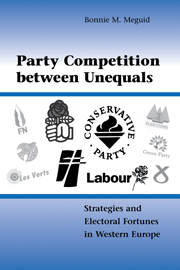Book contents
- Frontmatter
- Contents
- List of Tables and Figures
- List of Abbreviations and Acronyms
- Acknowledgments
- 1 THE NICHE PARTY PHENOMENON
- 2 POSITION, SALIENCE, AND OWNERSHIP: A STRATEGIC THEORY OF NICHE PARTY SUCCESS
- 3 AN ANALYSIS OF NICHE PARTY FORTUNES IN WESTERN EUROPE
- 4 A THEORY OF STRATEGIC CHOICE
- 5 STEALING THE ENVIRONMENTAL TITLE: BRITISH MAINSTREAM PARTY STRATEGIES AND THE CONTAINMENT OF THE GREEN PARTY
- 6 “THE ENEMY OF MY ENEMY IS MY FRIEND”: FRENCH MAINSTREAM PARTY STRATEGIES AND THE SUCCESS OF THE FRENCH FRONT NATIONAL
- 7 AN UNEQUAL BATTLE OF OPPOSING FORCES: MAINSTREAM PARTY STRATEGIES AND THE SUCCESS OF THE SCOTTISH NATIONAL PARTY
- 8 CROSS-NATIONAL COMPARISONS AND EXTENSIONS
- 9 CONCLUSIONS: BROADER LESSONS OF COMPETITION BETWEEN UNEQUALS
- References
- Index
- Cambridge Studies in Comparative Politics
3 - AN ANALYSIS OF NICHE PARTY FORTUNES IN WESTERN EUROPE
Published online by Cambridge University Press: 25 July 2009
- Frontmatter
- Contents
- List of Tables and Figures
- List of Abbreviations and Acronyms
- Acknowledgments
- 1 THE NICHE PARTY PHENOMENON
- 2 POSITION, SALIENCE, AND OWNERSHIP: A STRATEGIC THEORY OF NICHE PARTY SUCCESS
- 3 AN ANALYSIS OF NICHE PARTY FORTUNES IN WESTERN EUROPE
- 4 A THEORY OF STRATEGIC CHOICE
- 5 STEALING THE ENVIRONMENTAL TITLE: BRITISH MAINSTREAM PARTY STRATEGIES AND THE CONTAINMENT OF THE GREEN PARTY
- 6 “THE ENEMY OF MY ENEMY IS MY FRIEND”: FRENCH MAINSTREAM PARTY STRATEGIES AND THE SUCCESS OF THE FRENCH FRONT NATIONAL
- 7 AN UNEQUAL BATTLE OF OPPOSING FORCES: MAINSTREAM PARTY STRATEGIES AND THE SUCCESS OF THE SCOTTISH NATIONAL PARTY
- 8 CROSS-NATIONAL COMPARISONS AND EXTENSIONS
- 9 CONCLUSIONS: BROADER LESSONS OF COMPETITION BETWEEN UNEQUALS
- References
- Index
- Cambridge Studies in Comparative Politics
Summary
Tales of electoral disparity characterize the niche party experience. Across Western Europe between 1970 and 2000, niche parties promoting the same issues achieved wildly different levels of support. In Germany, the Grünen captured a peak vote of 8.3 percent and rivaled the centrist Free Democratic Party (FDP) for the title of the third largest party, whereas in equally environmentally friendly Denmark, the Green Party cobbled together a mere 1.4 percent of the vote in its most auspicious electoral performance. Similar tales can be told about the divergent fortunes of different niche parties within a given country. The strength of Spanish ethnoterritorial parties stands in sharp contrast to the electoral marginalization of their environmental compatriots, Los Verdes. Variation in niche party fortunes has also been witnessed across party life-spans. Voter support for the Greek green party peaked early and faded away, while the attractiveness of the Austrian Freedom Party continued to increase over the decades.
The goal of this chapter is to account for the variations in niche party fortunes across Western Europe. In Chapter 2, I argued that the solution to this puzzle of varying neophyte support can be found in the behavior of the mainstream parties. Rather than being solely or even primarily determined by the permissiveness of the electoral system or the rate of unemployment or economic growth in a country, the competitiveness of a niche party is largely a function of mainstream party strategic interaction.
- Type
- Chapter
- Information
- Party Competition between UnequalsStrategies and Electoral Fortunes in Western Europe, pp. 41 - 90Publisher: Cambridge University PressPrint publication year: 2008



